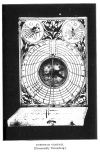
Chinese Occultism, by Paul Carus, [1907], at sacred-texts.com

Chinese Occultism, by Paul Carus, [1907], at sacred-texts.com

Click to enlarge
EUROPEAN COMPASS.
(Presumably Italian.)
The two plates are hinged together and fold upon one another in the same way as the European compasses shown in the following pages.
The lo-pan or net tablet unquestionably serves superstitious purposes, but we must bear in mind that much genuine science is incorporated in many of its details, and the latter no doubt has given countenance to the former. This again is according to the general law of the evolution of mankind and finds its parallel in the history of European civilisation. We must bear in mind that the great occultists of the Middle Ages, Paracelsus. Albertus Magnus, and

Click to enlarge
CHINESE POCKET COMPASS.
men like them down to Agrippa of Nettesheim, were the most powerful intellects of their day; and though they were deeply entangled in mysticism, much of their life's work was devoted to the furtherance of genuine scientific enquiry.
In the Chinese Middle Ages the leading thinkers were of the same stamp, and so it is natural that much of genuine astronomy and the results of accurate observation of the stars are incorporated in the lo-pan. The most obvious part of it which must have appeared

Click to enlarge
EUROPEAN COMPASS.
(Presumably Nuremberg.)
extremely mystifying in former centuries was, as the Chinese call it, the south-pointing needle—the mariner's compass—situated in the center of the lo-pan.
The south-pointing needle is an ancient Chinese invention which for some time seems to have been forgotten. Professor Friedrich Hirth of Columbia University has privately communicated to me facts which prove that it was employed in ancient times by travelers through the desert, that the invention was lost and had to be rediscovered. We would add, too, that the Chinese invention became known in Europe after the time of Marco Polo where it was soon used as a mariner's compass. The incident is well known and can easily be established on the testimony of literary sources, but while sauntering through the National Museum at Washington, the writer discovered a palpable evidence in the show cases there exhibited, which displayed the Chinese pocket instruments containing south-pointing needles presumably a few centuries old, side by side with European compasses. They are of the same oblong shape and consist of two tablets hinged in the same manner. The European instruments have sun-dials in addition and are decidedly more serviceable for practical use but we can not doubt that for the original idea our ancestors are indebted to our Mongol fellow-men. *